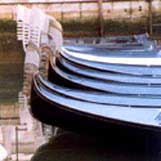Sights in Venice


Top Sights in Venice
The following is information about the top sights in Venice except for the Grand Canal and St. Mark's Square, which have been given their own pages.
Gallerie dell’Accademia- This gallery is a rival to the Uffizi in Florence and the Borghese in Rome. The focus of the works are from the 13th to 18th centuries. The 24 rooms are housed in a former church, which was deconsecrated in 1807 along with its monastery. The complex also houses Venice’s Academy of Fine Arts where you can follow the development of art from the Medieval period to the Renaissance, or trace the history of Venetian art.
Collezione Peggy Guggenheim- Located in the Palazzo dei Leoni off the Grand Canal, this museum is one of Italy’s best collections of avant-garde art. The building appears to be very short compared to those around it because it is only the ground floor of a 1749 palace that was never completed. Peggy Guggenheim, the American collector, lived here for 30 years until her death in 1979. This modern art marvel holds paintings from Jackson Pollock, Max Ernst (Peggy’s husband), Dali, Picasso, Kandinsky and many others. There is a permanent collection as well as frequent temporary exhibits. The courtyard contains several interesting sculptures.
Basilica della Salute (Santa Maria della Salute)- This church was built after the 1630 black plague as a thank you offering to God. The “St. Mary of Good Health” is a baroque landmark at the end of the Dorsoduro neighborhood across the Grand Canal from St. Mark’s Square. Its highlights include the Byzantine alter and the Titian painted ceilings.
Ca’ Rezzonico- This is one of the most opulent palaces on the Grand Canal. The palace was begun in 1649 and passed from one influential family to another throughout its history. The most famous resident was English poet, Robert Browning who died here in 1889. Today the palace serves as a museum of 1700's Venice. You can get a peak into the life of Venice’s rich and famous and step out onto the balcony for a beautiful view down the Grand Canal.
Basilica dei Frari- This church is the best example of Venetian Gothic. It was built in the 14th century and enlarged in the 15th century. There is a lot of art here, but there are three masterpieces that alone make it worth the visit. First is Titian’s “Assumption” high above the alter piece. Next you will find Donatello’s wooden sculpture of “St. John the Baptist,” and finally Bellini’s “Madonna and the Saints.” Bellini is considered Venice’s greatest painter and you will understand why when you see this famous altarpiece. For those who are not museum buffs, see these three pieces instead of visiting the Accademia. Note: You can also see an Austrian bomb that was dropped on the church during World War I and somehow failed to explode.
Scuola Grande di San Rocco- This building was decorated by Tintoretto from 1564 to 1587. The highlight is the upper floor’s ceiling which has 21 paintings on biblical subjects. Upon entering you are given mirrors (specchio) for the neck breaking view. Other works include those by Bellini, Titian and Tiepolo.
Ponte di Rialto- This is the most famous of the 3 bridges that cross the Grand Canal. The original was built of wood but started rotting, so it was replaced in 1588 with the current stone structure. The area around the bridge is where ships would unload their goods for the Venitian local markets. Today the bridge and surrounding area is loaded with tourist souvenir shops.
Ca’ d’Oro- This “house of gold” is one of the most magnificent Gothic palaces on the Grand Canal. Today there is only pink and white marble on the façade, but you can imagine how beautiful it was when it was built in 1422 and covered with gold. The building now houses a small museum.
Jewish Ghetto- The word ghetto became synonymous with neighborhoods set aside for Jews throughout Europe, and the Venetian Ghetto was Europe’s first. It was established in 1516 on an island that had only one bridge connecting it to the rest of the city. Each night the bridge gate was closed off to keep the Jews inside, and you can still see the grooves in the marble where the iron bars fit. Often Jews fled to Venice when they came under persecution in other places, and the neighborhood was expanded, creating an old and new ghetto. As people continued to arrive they were forced to build up, creating the tallest buildings in Venice and dubbed skyscrapers by locals. Hourly tours of the ghetto are available starting at 10:30 AM from the Museo Embracio.
Travels with Friends: Learn more about other European destinations and tips for traveling within Europe. www.TravelsWithFriends.com
Private Guides: See Europe and learn about its history with your own private guide. www.PrivateGuidesInEurope.com

Europe travel news sent to you 15 times a year.
Top sights, hotel reviews, travel tips and more.
Private Tours in France, Greece, Italy and Spain.
Join one of our small group Europe tours.
Tours and day trips to help you explore Europe.
Hire a professional from Private Guides in Europe.
Let us help personalize your European itinerary.
Our thoughts on how to best travel in Europe.
For more information or to send us an email.
Car Rentals, Flights, Hotels, Rail Passes
